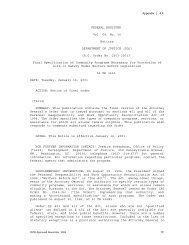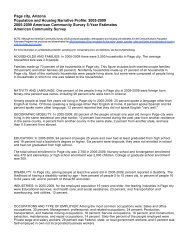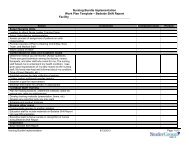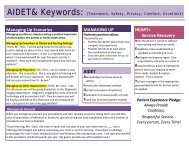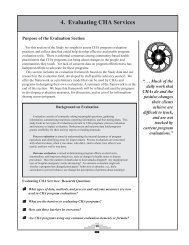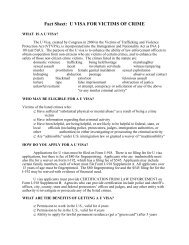Arizona Rural Health Clinic Designation Manual - Arizona Center for ...
Arizona Rural Health Clinic Designation Manual - Arizona Center for ...
Arizona Rural Health Clinic Designation Manual - Arizona Center for ...
Create successful ePaper yourself
Turn your PDF publications into a flip-book with our unique Google optimized e-Paper software.
B. Interpretive Guidelines <strong>for</strong> <strong>Rural</strong> <strong>Health</strong> <strong>Clinic</strong>s (con’t)<br />
to 4 (18 hours a month). In this situation, it is appropriate to consider the clinic’s total monthly operating<br />
schedule <strong>for</strong> determining whether RHC services are offered during at least 51 percent of the schedule. A<br />
physician, a nurse practitioner, certifi ed nurse-midwife, or a physician assistant must be available to furnish<br />
patient care services every other Tuesday from 10 to 4, and one Friday from 10 to 4 (18 hours a month).<br />
Of these 18 hours, a nurse practitioner, certifi ed nurse-midwife or physician assistant must be available at<br />
least 9.18 hours to furnish patient care services.<br />
C. Staff Responsibilities. The requirement that a physician, physician assistant, certifi ed nurse-midwife,<br />
and/or nurse practitioner participate jointly in the development of the clinic’s written policies does not require<br />
the development of new policies in the event of changes in these staff members. Nevertheless, each staff<br />
member must review, agree with, and adhere to, or propose amendments to the clinic’s policies. Compliance<br />
with this requirement has a special relationship to the clinic’s written patient care guidelines. There should<br />
be suffi cient written documentation that this requirement is appropriately carried out. There should be some<br />
mechanism to ensure that new clinic personnel are completely familiar with these policies.<br />
1. Physician Responsibilities. Ascertain through written documentation, such as dates and signatures, that<br />
the physician staff member satisfactorily meets the requirement of periodically reviewing the clinic’s patient<br />
records, provides medical orders, and provides medical care services to the patients.<br />
A physician member is required to be present in the clinic <strong>for</strong> suffi cient periods of time to per<strong>for</strong>m the duties<br />
and responsibilities described in 42 CFR 491.8(b)(i), (ii), and (iii). The term “suffi cient periods of time”<br />
requires relative evaluations. There are a number of elements to consider in weighing what would constitute<br />
a reasonable time suffi cient to discharge the physician member’s responsibilities. These elements include:<br />
patient case load and mix (type), number of patient care records which must be reviewed in order to<br />
establish a good overview <strong>for</strong> adherence to policies and principles of quality patient care, number of patient<br />
care records which require review and discussion of specifi c health problems and regimens of therapy;<br />
need <strong>for</strong> consultative time with other members of the clinic’s staff; need <strong>for</strong> revision to the clinic’s patient<br />
care guidelines; and need <strong>for</strong> time to provide medical care to patients.<br />
Time required to accomplish these activities will fl uctuate. Thus, the “sufficient time” the physician must<br />
spend in the clinic will vary. The survey should verify the time spent in the clinic by the physician <strong>for</strong><br />
consulting records, etc. Extraordinary circumstances which constitute exceptions to the requirement that<br />
the physician Member be present in the clinic at least once every 2 weeks <strong>for</strong> “suffi cient time to discharge<br />
the physician’s responsibilities are primarily nonrecurring circumstances beyond the control of the physician<br />
and which postpone (not cancel) the visit. These circumstances include illness, extreme weather or driving<br />
conditions of short duration, or those emergencies which occur in the physician’s practice and require his<br />
presence elsewhere. When nonrecurring circumstances cause postponement of the physician’s visit, they<br />
should be documented in the clinic’s records.<br />
In some instances, recurring extraordinary circumstances may constitute reasonable exception to the<br />
physician’s presence requirement. This type of exception requires specifi c approval from the CMS RO <strong>for</strong><br />
certifi cation purposes, and must be documented by the surveyor. The essential areas <strong>for</strong> consideration of<br />
this exception would include:<br />
-- The remoteness of the clinic (due to extraordinary distance and inaccessibility of the terrain)<br />
make frequent travel impossible or unreasonable;<br />
-- The remoteness of the physician members location has already placed the physician in an<br />
extraordinary extended practice and/or designated shortage area and required visits at<br />
least once in every 2 week period to a clinic located at a great distance would severely detract<br />
from the physician’s practice; or<br />
-- It is clearly established in advance that continuing conditions are known to be expected (snow,<br />
fl ood, bridge repair, etc.) which will make reasonable access to the clinic not possible<br />
<strong>for</strong> extended periods of time.<br />
22



